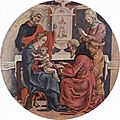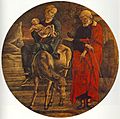Roverella Altarpiece facts for kids
The Roverella Altarpiece was a large religious painting made by an artist named Cosmè Tura. He worked on it between 1470 and 1474. This artwork was created using oil and egg-tempera paints on wooden panels.
A church leader named Bartolomeo Roverella asked Cosmè Tura to make this painting. It was for the Basilica of San Giorgio fuori le mura in Ferrara, Italy. Bartolomeo wanted the painting to honor his brother, Lorenzo Roverella. The Roverella Altarpiece was one of Cosmè Tura's most important works. It was also a very significant piece of art from the Ferrara Renaissance period.
Sadly, the altarpiece was damaged in an explosion in 1709. After that, it was moved out of the church. Today, the painting is no longer one whole piece. Its different panels are now kept in several museums around the world.
What Was the Altarpiece Like?
We know what the altarpiece looked like thanks to a description from the 1700s by Girolamo Baruffaldi. Based on this old information, an artist named Maurizio Bonora later drew a picture showing how it might have looked.
The altarpiece had six main panels. In the very center was a large painting of the Madonna and Child Enthroned. This means it showed Mary (the Madonna) and baby Jesus sitting on a throne. On each side of this central panel were two smaller panels. These panels showed saints and members of the Roverella family. Above these side panels, there was another panel with a saint kneeling.
At the very top of the altarpiece was a large, curved panel called a lunette. This part showed the Pietà, which is a scene of Mary mourning over the body of Jesus. This part of the painting was very emotional. It might have been inspired by similar sculptures popular in the Romagna area at the time.
At the very bottom of the altarpiece was a section called a predella. This part was made up of several round paintings, possibly seven. Today, we know where three of these round paintings are.
Only one of the original side panels is still together. This panel shows Saints Maurilius and Paul with Niccolò Roverella. In this painting, you can see Cosmè Tura's special style. He made the clothes look heavy and wet, with strong shadows and light. The altarpiece also had amazing perspective, making the backgrounds look deep and real. You could see the detailed ceilings in the painted buildings, especially in the central panel.
Where Are the Pieces Now?
Here are the parts of the altarpiece that we know about today and where they are kept:
- Pietà with Saints, 132x267 cm, at the Musée du Louvre in Paris, France. This was the upper lunette.
- St George, 39x29 cm, at the San Diego Museum of Art in San Diego, USA. This is a small piece from the main left panel.
- Madonna and Child Enthroned, 239x102 cm, at the National Gallery in London, UK. This was the large central panel.
- Saint Maurilius and Saint Paul with Niccolò Roverella, at the Galleria Colonna in Rome, Italy. This was the main right panel.
- Circumcision of Christ, a round painting 38 cm across, at the Isabella Stewart Gardner Museum in Boston, USA. This was one of the predella pieces.
- Flight into Egypt, a round painting 38 cm across, at the Metropolitan Museum of Art in New York, USA. This was another predella piece.
- Adoration of the Magi, a round painting 38 cm across, at the Fogg Art Museum in Cambridge, Massachusetts, USA. This was also a predella piece.
It is believed that the lower left panel originally showed Saints Lawrence and George. The small St George fragment in San Diego might be a part of this damaged panel. According to Girolamo Baruffaldi, Saints Bernard and Benedict were also supposed to be in the altarpiece.
Images for kids








